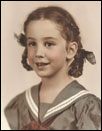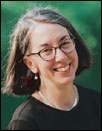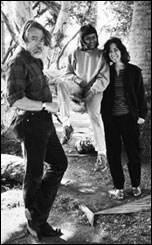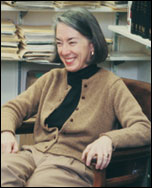 |
 |
 |
 |
|
FEATURES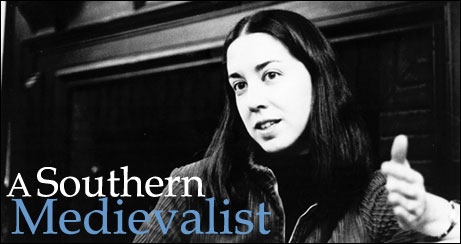 University Professor Caroline Walker Bynum Reflects on Influence, Identity and Teaching By Mary Jungeun Lee '01 Stacks of papers are neatly arranged in rows in her Fayerweather office, with bright, crystalline rocks serving as paperweights. A bulletin board hangs along one wall, overfilled with flyers — reminders of future talks and panel discussions. One flyer includes a photograph of herself without her large glasses, which tend to dominate her small face; it is paired with a photo of her mother as a young woman, and a heading about an upcoming talk on metamorphosis spans the two photos. Other photographs are pinned next to these flyers, including one of her standing with her Contemporary Civilization class in her Riverside Drive apartment after a catered dinner. Alongside are photos of some of her graduate students and their babies. This office in Fayerweather is a sanctuary, one whose quiet is occasionally broken by the sound of a horn or a car alarm from Amsterdam Avenue. Books lie open on her two desks, surrounded by more stacks of papers, post-it pads, and students' papers with detailed comments penciled in along the margins. Endless volumes line the walls, all neatly arranged into categories — from current projects and specific courses she is teaching to new scholarship in medieval research. Judging from this mini-library on the Middle Ages, some might presume the occupant of this office to be a self-absorbed academic, one who prefers surrounding herself in the Ivory Tower with her books and her neatly stacked papers and insulating herself from the anxious students waiting for office hours to begin. This is hardly the case. Caroline Walker Bynum is one of the most widely recognized names in European history, and perhaps the most important name in medieval studies today. She is the author of such pioneering books as Jesus as Mother: Studies in the Spirituality of the High Middle Ages (University of California Press, 1984); the Philip Schaff prize-winning Holy Feast and Holy Fast: The Religious Significance of Food to Medieval Women (University of California Press, 1988); Fragmentation and Redemption: Essays on Gender and the Human Body in Medieval Religion (Zone Books, 1990), and The Resurrection of the Body in Western Christianity, 200-1336 (Columbia University Press, 1995), which was awarded the Ralph Waldo Emerson Prize of Phi Beta Kappa as best book of the year in 1995 on "the intellectual and cultural condition of man." Small wonder that, with six honorary degrees and some 11 books and 34 articles to her credit, she was named University Professor in 1999 — the first woman in history to be awarded Columbia's highest faculty honor. University Professors, of which there are 12, are named in recognition of exceptional scholarly merit as well as distinguished service to Columbia, and are permitted to teach in any department of the University. Yet there is another side to this Southerner, one that her books can't convey and that her spacious Fayerweather office only hints at. Sure she's serious, but always with a light-hearted laugh and raised eyebrows that seem to say that the pretentious are intolerable. Bynum is petite, with a Southern drawl, owl-rimmed glasses and a bobbed haircut that frames her thin face. Standing in front of her classes, she constantly gesticulates with her tiny hands, insists that her students read works like The Republic and Leviathan to better understand their own convictions, and isn't afraid to issue a "Writing Advisory!" to students whose grammatical mistakes have "annoyed Professor Bynum." This southern medievalist may be small in stature, but she is no pushover — nor is she quiet. Bynum presses her students to overcome timidity, to "share ideas" because "the class would benefit from your intelligence." She's a teacher who cares enough to continuously press her students to improve their writing, because it is a life-long challenge to "clearly express one's ideas." A typical comment: "Some great ideas here — but learn to be more forthright with them." To unwind from the rigors of academia, Bynum explores home-style recipes as what her grandmother called a "good plain cook." She loves cabbage dishes, but no longer cooks many of them because her husband is German and over the years has grown tired of the vegetable. An avid reader of fiction, Bynum also loves baroque opera, having developed this appreciation while living in Berlin. She often takes walks along Riverside Drive with friends from the Columbia faculty. She also enjoys other areas of New York City and the plethora of museums, particularly the Metropolitan, where she took students from her spring seminar, "Medieval Religious Thought & Practice," to view the reliquaries and crucifixes and discuss ideas they had read and talked about in their Fayerweather classroom. Southern Roots in the Middle Ages Teaching has always been an integral part of Bynum's career and personal life. She held professorships at Harvard, the Harvard Divinity School and the University of Washington before coming to Columbia in 1988. However, her love of ideas, and the sharing of them, long predates her formal teaching positions.
Daughter of professors Merle and Andrew Jackson Walker, Bynum grew up in Atlanta in a liberal Southern household fueled by intellectual ideas, from metaphysical questions about time to the classics of English literature. "I think the kind of historian that I became — historian of ideas, historian of religion, intellectual historian, a historian strongly interested in interpretation, not just in seeking out the facts — was strongly influenced by growing up with a mother who argued philosophically." Growing up in the South also had a tremendous influence on her interest in the Middle Ages. Sitting amidst her books in her Fayerweather office, Bynum says, "It is often pointed out that the antebellum South is like the Middle Ages, that living on a Southern plantation has affinities to the great estate in the ninth century. Plantations, ladies in long dresses, a military culture for the men — that's Southern; that's the antebellum South." Her Southern roots meant more than just a curiosity with the past; they also meant a coming to terms with one's past. "I think the American South is the part of the United States with the strongest sense of history," she says, "the strongest sense of being rooted in a past, and the strongest sense of a complex relationship with the past. After all, if you have Southern ancestors, you grow up in a defeated country and you grow up in a country that was defeated for what you think was the right reason; you come from a region that lost a war, and you should have lost the war; you were fighting for the wrong thing. You have a very complicated relationship with the past because you're always thinking, 'What can I preserve, but what do I give up?' Questions about influence, the self, the person and giving something up have always been issues that intersect in Bynum's personal and professional life. As a historian of medieval religion, Bynum studies different factors that triggered divergence in thought and religious practice in the European past. In the fall of '98, Bynum asked her CC class what it means to die for beliefs, for interpretation, for convictions — a broader question about Socrates and Perpetua, those greats of the Western past, whose texts have survived more than 1,800 years and are studied today by all College students. This question also permeates her personal life, manifesting itself in her scholarly interests in religion. "I had a very strong religious upbringing that led me to be interested in the Middle Ages and in negotiating some kind of relationship with something I am not 100 percent enthusiastic about, but that I don't also simply want to jettison. So, the South and the Christian Church are both things about which I feel ambivalent, but also not which I feel I'm ready to throw away." The Move North Like so many other teenagers, Bynum needed to leave her home to explore new and different places. She moved out and headed for Boston to begin her university education at Radcliffe. "I had never been out of the American South for a single day and I was anxious to get away," Bynum recalls. As a 17-year-old freshman, Bynum immediately felt the differences that distinguished her from her Northern peers. She felt her identity inextricably defined by her Southern background, with assumptions about her character, intelligence and social mores. "Being a Southerner was difficult," she says. "There was a lot of Northern prejudice. I was from the last non-integrated high school class; integration had just come in and the civil rights movement was getting strong. It was a very activist time and many Northerners from protected backgrounds that I went to school with came from great wealth and great social privilege, which of course I did not." "I spoke differently," Bynum adds. "Among other things, as a Southerner, people thought that I was racist; they just assumed that you were racist if you came from the South. I remember once around Thanksgiving time of my freshman year, I was in Harvard Square with someone who lived in my dorm. We were walking around and talking and suddenly, she looked at me and said, 'You know, you're not stupid.' And I just looked at her and she said, 'I always thought that you were stupid because you talked so funny.' That's how it was. People were not sensitive to difference." As a girl growing up in the South and as a student in the late '50s and early '60s, Bynum faced very different expectations from those most American women face today. Bynum and her generation of women encountered what she describes as a "classic double bind." Reflecting on psychologist Matina Homer's theory on women and success, Bynum says, "There was an expectation that women would avoid success because they were on two tracks that conflicted. In other words, you were expected to be bright and an achiever, and you were also expected to marry; and those were expected to be in conflict. You were expected to choose one or the other. And you can't win in that situation." Midway through Radcliffe, Bynum found herself caught in this double bind. She got married and later began publishing under her husband's name, and continued to publish under that name after their divorce. "I got married at the end of my sophomore year and I transferred to the University of Michigan because my husband was in law school there. This was, again, the double bind, the double pull. There I was on the fast track at Radcliffe and I had decided to leave and transfer to Michigan." Time had suddenly hit her. Bynum thought that if one didn't get married when first asked, then maybe one would never get married, a pressure that even today she finds hard to explain. "It is crazy to think now how those pressures were on women," she says. "It was a complicated decision, very much like my mother's decision to leave teaching." Leaving Radcliffe, a scholarly world she had grown to love, Bynum nevertheless found the highest level of education at Michigan, enrolling in the very selective Honors Program. After graduating with high honors, Bynum returned to Cambridge to begin doctoral work at Harvard in medieval history, a specific period that she had not concentrated on as an undergraduate. It was during her graduate work that Bynum focused on medieval history and found her voice. Her love for teaching flowered.
Today, Bynum, whose work — such as Jesus as Mother, the award-winning Holy Feast and Holy Fast, and The Resurrection of the Body — often flows beyond departmental boundaries, is always interested in discussing the complicated nature of method, interpretation and perspective. "Everything is from a particular point of view and perspective," Bynum reminds her students. "In complicated interpretations, one always has to factor in that one is making an interpretation." For Bynum, intelligent reading is a fundamental part of her role as teacher. It is a practice she believes can best be taught by example. "You can't give students five rules on how to read and expect them to go out and do it," she says. "You want to try to get students to find something that they love. That's when you can really make an impact." This fervor for close, careful and slow reading comes from a woman with a long record of academic achievements. Flipping through her curriculum vitae is a humbling experience. The lists of awards, publications and distinctions cover 14 pages. Bynum's impressive C.V. seems to shout that she always knew what she wanted to do. Bynum, however, sees it from another perspective. "If you look at it one way," she said, "it looks as if I always knew what I wanted to do. But in another way, it looks like I was always backing myself into corners, making it hard to do it. And like I said, it was something women in my generation tended to do." "I think I always knew what kinds of problems fascinated me and that I wanted to work on those problems," Bynum adds, "but I think that I did not know what was going to happen in the social context, and I didn't know the departmental or disciplinary boundaries. I was having a hard time figuring out who I was, in terms of discipline. I'm not really a conventional medievalist. I seem to get letters all the time addressed to 'Caroline Bynum, Art History,' 'Caroline Bynum, English,' 'Caroline Bynum, Comparative Literature,' or 'Caroline Bynum, Department of Religion;' people who read my books don't know, even today, what department I'm in. So in that sense, I had a hard time settling in." Even in the process of writing a book, Bynum says, "I flail around here, there and yon. But when I figure out what it is that I want to work on, I feel as if I have come home. I somehow know when I come to it, this is the kind of topic that I want to work on. Some of that was always there, even when I was in high school and in college. I remember in college I wrote a paper on which the professor had written at the bottom, 'A+. But, this isn't history.' And I kept on having experiences like that. People would say, 'Whatever this is, it's excellent. But it doesn't fit our rubric. It isn't what you're supposed to be doing in this class.'" Yet perhaps excellence comes from an ability to think beyond the categories that can constrain a person. Perhaps it comes from doing what she knows she's supposed to be doing, rather than what others tell her she should be doing. Sexual Politics Though she has had challenges settling into departmental categories, Bynum always has been sure of her love of teaching, even while battling sexual politics in the '70s. While an assistant professor of history at Harvard, Bynum became increasingly conscious of the deeply rooted sexism of the academy and of her identity as one of only 12 female professors throughout the entire university. Aware of the changes yet to be made, Bynum and a colleague founded the Committee on the Status of Women, producing a report, "The Status of Women in the Faculty of Arts and Sciences," that has since been studied by feminists, such as Parr Professor of English and Comparative Literature Ann Douglas, as a treatise on the state of academia and women. Bynum received hate mail for fighting for women; she was stalked for six months because of her radical demands. Yet, she admits, "It was also, in a curious kind of way, fun. I knew there was no chance that I would be kept on at Harvard, so somehow I didn't have to worry about that. I knew that it was wrong that there were few women at Harvard and the right thing was to get more. Pure and simple." Bynum and her committee found discriminatory procedures justified by the university that echoed the condition of women in professional careers in the '70s. "We discovered that the art history department had two lists. They had a list that ranked students according to their credentials for admissions. And they had a list according to which they gave fellowship money. On the first list, all the women were at the top. And on the second list, all the women were at the bottom. They did this because they said that women aren't a good investment — they could have babies and drop out." The pressure of being a woman in a male-dominated profession, and making her voice heard in a politically charged era, was nothing compared to the tragedy of losing a close friend. Cambridge was the site of a violent event that changed Bynum's views and her life forever. "The same year when I was at Harvard and on the Committee on the Status of Women, and under a lot of pressure, my closest friend was raped and murdered." "It sometimes seems as if my life divides into two parts," Bynum adds. "Somehow after that, I stopped thinking that there is any justice in the world at all; and since I accepted that there is no justice in the world, I decided that there is no point in complaining about anything. There was no point to self-pity. You couldn't just sit around and say, 'It's not fair. It's not fair that women are discriminated against. It's not fair that I can't have children.' Because, who on Earth would listen? "It made me a lot tougher. Somehow connected to that was the decision to leave Harvard, to go to Washington, to adopt a child. It threw me back on myself. And somehow after that I knew that that's what you've got — yourself." A Specific Breed of Historian
Bynum's time as professor of history at the University of Washington and as a new mother belied the claims of her former Harvard colleagues — she certainly was not someone who would have babies and drop off the face of academia. Instead, she achieved greater distinction than most men in her field, even while raising a daughter. She is a no-nonsense woman, serious about her teaching, serious about her writing. While her daughter took afternoon naps, Bynum took up pencil and paper and began writing about Christian iconography and women who experienced the raptures of Christ's flesh. Balancing her life in this way, she was able to move seamlessly from packed lecture halls to finger-painting with her daughter to seeking her notepad to jot down thoughts during the quiet moments of the afternoons while her daughter slept. Switching gears quickly resulted in the publication of Jesus as Mother and the book that established her arrival as a major intellectual voice, Holy Feast and Holy Fast. "It was a juggling act," says Bynum. "But it was a doable juggling act." A male colleague commented on her level of energy and her ability to be so prolific, and Bynum admits to thinking at that time, "I write my books when you play squash, eat lunch, gossip in the halls." She doesn't care as much for brown-bag lunches as she does for seeking out more evidence on the lives of medieval women and their food asceticism. She doesn't care for departmental politics as much as she does for improving her students' writing. Thinking about the kind of historian she has become, Bynum goes back to a moment when she was a child. "One of the earliest memories that I have is of the ending of the Second World War," she reflects. "I remember being off with my parents at a lake. Everybody was clustered around the radio. I remember pulling on people and asking what's going on and being told that the war was over. Then I remember going home, and the children in the neighborhood went out on the street with little American flags. We paraded up and down, shouting, 'The war is over, the war is over.' "I think that has something to do with becoming a European historian. In my childhood, Europe — what was happening in Europe — was absolutely formative. My father thought that FDR was the greatest hero in the history of the world. And the horror of the Holocaust was coming out.… I think it made a kind of orientation toward Europe that's hard to understand now." Bynum, a former president of the American Historical Society and the American Catholic Historical Association, wrote about this strong sense of Europe in an article, "The Last Eurocentric Generation." "I wrote about why, for us, Europe was the center — not only as a historical issue, but also as a moral issue," she explains. "Europe really carried the burden of things one had to sort out about what it means to be human. That's not true anymore. What I was trying to think about in that 'think piece' was, 'What does it mean as one moves away from European history being done by people like me, who were Eurocentric, to people who would be doing European history and enjoying it, but won't be Eurocentric anymore?'" "Europe is not going to be the lone star, the weight, the fulcrum, the way it was for my generation. And I think it's in part because of the war, when we were fighting for other people, against other people, on another continent. It was a different sort of question. That makes a difference. And that has something to do with the kind of historian that I am." Whether labeled European or medieval, Bynum is a historian whose contributions to the Columbia community are "extraordinary," according to Jonathan Cole '64, provost and dean of faculties of the University. Describing her as "a great and demanding teacher," Cole adds, "When we try to think of the great historians working today, the name Caroline Bynum comes immediately to mind. With consummate skill, incredible erudition and scholarly depth, along with an innovative point of view, Caroline has opened up entirely new areas of medieval history." Change and Continuity
In her newest book, Metamorphosis and Identity (Zone Books, 2001), Bynum explores images in the Middle Ages that convey shifts in paradigms and different understandings of change. As always, Bynum considers contemporary notions of change and the concepts and images that we have in our lives. For Bynum, witnessing her father develop Alzheimer's and his metamorphosis influenced her intellectual interests in these ideas. She would visit her father against others' recommendations that she shouldn't, because he might not recognize her or know that she has a daughter of her own. To Bynum, it didn't seem right that this tremendously intellectual man, who inspired her interests in literature, would still gesture as if tipping his hat like a Southern gentleman (when it had been years since he'd worn a hat) and not be the same person. So Bynum continued to visit her father regularly and thought further about what it means to change, what it means to have an identity. "In a funny kind of way, these things that seem like personal tragedies also have intellectual significance," Bynum says. "What does it mean for a person to survive in a postmodern world? We don't, any longer, believe that we are the same person from moment to moment — in terms of body, or even in terms of memory. We know how labile and changeable memory is. You can't just say, 'The person's the body or the person's the soul or the person's the person.' It's very problematic. How, then, can one talk about what it means to be a person over time?" This is a question her students tackle in reading about the lives of medieval women like Dhuoda, Hildegard of Bingen, Catherine of Siena, and Margery Kempe. It is also a question Bynum asks in thinking back upon her own life, from waving an American flag as a young Southern girl celebrating the end of the war to the medievalist she is today, writing about identity in the Middle Ages. In discussing Gerald of Wales in Metamorphosis and Identity, Bynum writes, "Identity tends to have divergent denotations. Nonetheless change is the test, the limit, of all denotations of the term 'identity.' I may, for example test what constitutes my identity understood as personality by imagining what would have to change through a mental illness such as Alzheimer's in order for 'me' to cease to be 'me.'" Her dedication to teaching and her insistence that people think carefully about particulars — whether it's in the classroom, for a weekly "think piece" writing assignment, or in one's personal life — are eye-opening and transforming experiences that her students take away from Columbia. A single conversation with Bynum always has intellectual questions with significance to one's academic work, and, more importantly, significance to life experiences. "You trust people you've shared ideas with," she points out to her students. "If you really talk, whether it is about Heloise and Abelard, or whether it's the war in Bosnia, or whether it's genetic research, with professors you know, maybe you could start talking to them about what you're going to do after graduation. Then you've got a real advising relationship." Bynum, 60, plans to continue teaching for at least another 10 years, and will continue to urge each wave of students to read thoughtfully, always asking questions about the past and the present with as much care to one's own assumptions as to the books that teach us. She does not prefer the Ivory Tower to the fascination of the world. She loves ideas; as a historian, she is constantly seeking what is behind them, and as a teacher, she is constantly urging her students to do the same. About the Author: Mary Jungeun Lee '01, an English
major at the College, now works for the A&E cable
network. |
|
|||||||||||||||||||||||||||||||||||||||||||||||||||||
